| |
Home
Famous and Fascinating Women in History
Frontiersmen and Women
The World's Greatest Composers
Famous Women Spies
Great Authors of the World
Generals and other Noteworthy People
from the Civil War
The Presidents of the United States
The First Ladies of the United States
Homes and Monuments of and to
Famous People
Historical People and Events by Month for Each Day of the Year!
Famous Figures in Black History
The Calvert Family and the Lords Baltimore
Understanding the American Revolution and its People
Everything Beatles!
Everything Maryland! |
| |
|
 
|
| |  |  |
 |  | 
Hampton National Historic Site
Written and Edited by
John T. Marck
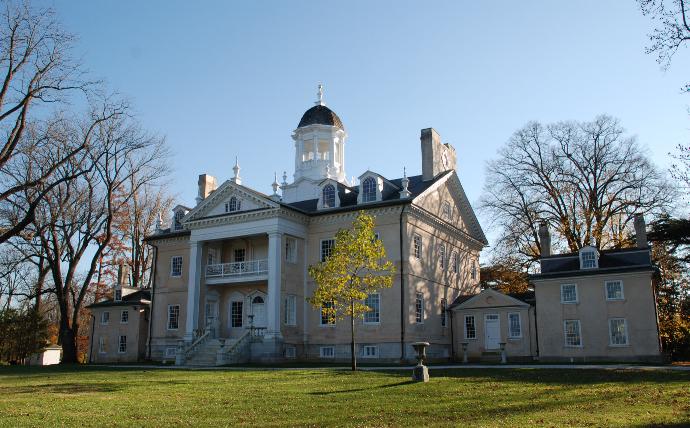
Upon visiting
the Hampton National Historic Site and Mansion, you will experience how the
seven generations of the Ridgely family left their legacy. This is seen
through various collections, outbuildings and gardens, and through the Mansion
itself. Each room of the mansion depicts a different era, giving visitors a
total experience of what life was like, living here.
Over
ninety-percent of the objects on display are original. The Mansion, together
with the Lower section that consists of the Overseer’s House, Slave Quarters,
Dairy and Formal gardens offer the complete experience to America’s past. Park
Rangers tell Mansion story of entrepreneurs, indentured servants, slaves and
the changing face of Hampton from 1745 to the present day.
Hampton’s Origin and First Master
The Mansion
estate known as Hampton began and evolved from several tracts of land acquired
by the Ridgely family starting with 1500-acres known as “Northampton” in 1745.
Other land tracts included “Oakhampton,” and “Hampton Court.” The “Hampton”
name is believed to be originated with Colonel Henry Darnell, a relative of
Lord Baltimore for whom the property was originally surveyed in 1695. Darnell
gave Northampton to his daughter, Ann Hill (1680-1749), and she and her two
sons, Henry and Clement, sold the tract to Colonel Charles Ridgely in 1745.
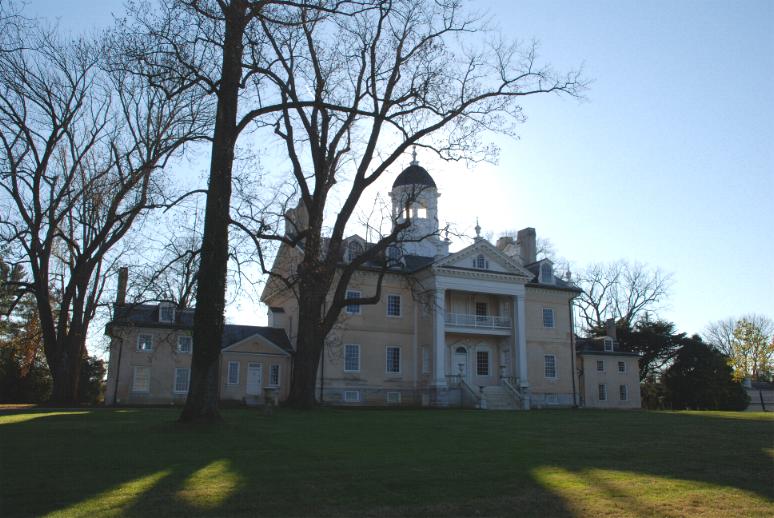
The entire
tract of Northampton, which consisted of houses, outhouses, tobacco houses,
barns, stables, gardens and orchards cost 600 pounds sterling. By 1750,
Colonel Ridgely owned more than 8000 acres in Baltimore and Anne Arundel
Counties. Ridgely, in addition to his being a plantation owner and planter,
was a successful merchant and served in the Maryland Legislature as a
representative for Baltimore County.
The colonel,
having recognized that iron-making was a better economic opportunity than
tobacco farming, established an ironworks in partnership with his sons, John
and Charles. The younger son, Charles, known as captain as he was a mariner
and ship’s captain, married Rebecca Dorsey, the daughter of Caleb Dorsey, and
very prominent and wealthy Anne Arundel County ironmaster. The Northampton
Furnace and Forges, established in 1762, was the tenth such ironworks in
Maryland and they took advantage of the easily mined iron deposits in the
area. The Northampton Company went on to make a substantial fortune for the
Ridgely family both before and during the American Revolutionary War.
Captain
Charles Ridgely had served in the 1750s as a ship captain, and his various
maritime experiences included: Suppressing a mutiny, surviving two hurricanes,
and being captured and imprisoned by the French during the French and Indian
War. In 1763, he retired from his maritime duties, and assumed total control
of the family iron business. However, he did remain an active agent for
British merchants until the Revolutionary War. In addition to his mercantile
business in Baltimore Town, he owned farms that cultivated grain and vegetable
crops, bred cattle, pigs and Thoroughbred horses, and planted a commercial
orchard, as well as operated mills and quarries.
In 1771,
following the death of his brother John, and his father’s death in 1772,
Captain Charles Ridgely owned two-thirds share in the Northampton Ironworks
and therefore maintained control of the entire operation. Running the
ironworks was very labor-intensive. To do so, it relied on a large workforce
that consisted of slaves, indentured servants, convict laborers, and even
British prisoners of war. The war also created a market for the forge’s
products, such as shot, cannons, and camp kettles. The large amounts of income
derived from the various enterprises enabled Ridgely to buy thousands of acres
of land that had been previously confiscated by the British immediately
following the War. In total, Ridgely now had more than 24,000 acres of land.
With his
fortune, Captain Charles Ridgely was now able to afforded his finest
achievement; the building of the Hampton Hall Mansion House. Considered the
“house in the forest,” it began in 1783, as the American revolutionary war was
coming to a close.
In order to
build such a house, workers comprised free craftsmen, indentured servants, and
enslaved African-Americans labored for 7 years, when the house was completed
in 1790. This house represented to Ridgely his “American Dream,” and it stood
as the centerpiece of the Northampton Estate, which comprised 18,000 acres.
Upon completion it was believed to be the largest private home in America at
the time, and served as the summer residence. Captain Ridgely also owned a
house in Baltimore Town, and another on Patapsco Neck in southeastern
Baltimore County.
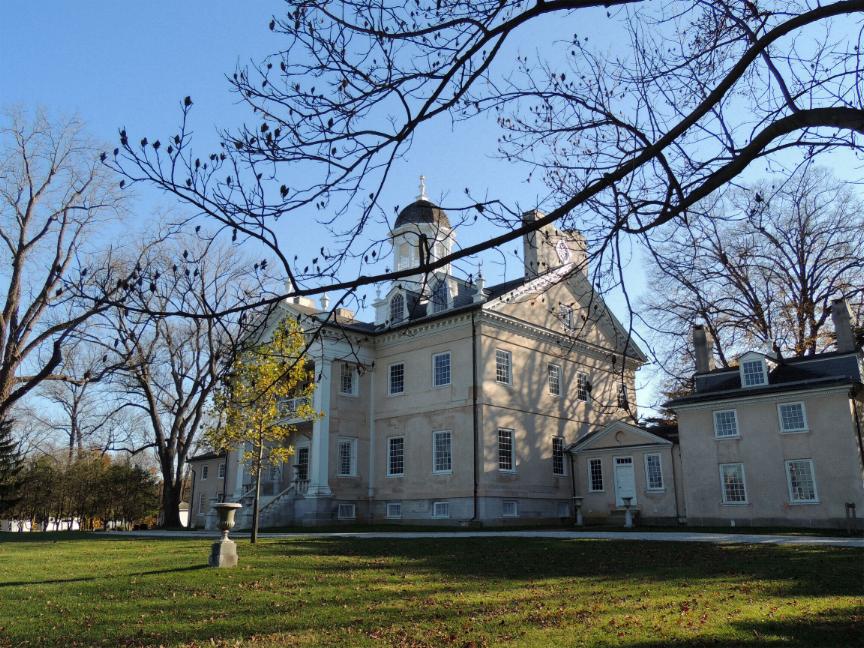
During the
construction of Hampton Hall, the Ridgely family resided in the Lower House.
Ridgely supervised every aspect of construction as well as the cost. Captain
Ridgely’s wife, Rebecca moved into the Hall in December of 1788, although the
interior was not completed until 1790.
Charles Ridgely Carman, Hampton’s Second Master
Living with
Captain Charles Ridgely and his wife Rebecca in the Mansion in 1788 was
Charles Carnan Ridgely (born Charles Ridgely Carnan) and his wife Priscilla
Dorsey Ridgely. Charles Carnan Ridgely was the son of Captain Ridgely’s sister
Achsah and her husband John Carnan. Charles Carnan Ridgely being Captain
Ridgely’s nephew eventually worked as his uncle’s junior partner and would
become the Mansion’s second Master.
Because
Captain Charles Ridgely and his wife Rebecca had no children, Charles Carnan
Ridgely would become their principal heir. In his uncle’s will, he inherited
12,000 acres of land, that included the Hampton Mansion estate, two-thirds
ownership of Northampton Iron Furnace, other ironworks interests, and other
property, on the condition that he change his surname to Ridgely. By an Act
of the Maryland Legislature, November 5, 1790, Charles Ridgely Carnan, his son
Charles, and al their descendants adopted the surname of Ridgely. In Captain
Ridgely will was also established a “courtesy” entail to protect the core of
the Hampton estate: hall, gardens, and grounds and the Home Farm passed
continuously to the eldest Ridgely son. This entail was followed to the letter
until the estate was transferred to the National Park Service in 1948.
Throughout his
life, Charles Carnan Ridgely served as a representative from Baltimore County
in the Maryland Legislature from 1790 to 1795, as a state senator from 1796 to
1800, and a three-term governor of Maryland from 1815 to 1818. He was known
throughout his life as General Ridgely; Charles Carnan Ridgely’s military
record peaked with his appointment as brigadier general in the state militia
in 1796.

John Carman Ridgely, Hampton’s Third Master
Charles
Ridgely the second master serve d as such from 1790 to July 1829, when he died
from an attack of paralysis. He and his wife Priscilla Dorsey Ridgely had
fourteen children together, of which eleven lived to maturity. Upon the death
of Charles (second master) his will instructed that many of his slaves be
manumitted (freed). This manumission of more than 200 people was one of the
largest in Maryland history. The Mansion house and about 4500 acres of land
was bequeathed to his second son, John Carnan Ridgely, (1790-1867) the new
third Master.
John was the
first child born a Hampton Hall in 1790, but his life was different, not
having any of the ambition of the mansions first two masters. In 1812, he
married his wife, Prudence Gough Carroll (1795-1822). Together they would have
six daughters, but none survived childhood. Prudence died in 1822, and in
1828, John married his second wife, Eliza Eichelberger Ridgely, the only child
of Nicholas Greenbury Ridgely, a prominent Baltimore merchant. Although they
believed they were distant cousins, no descent was ever established. They
would have five children, two of whom survived to adulthood. They were Eliza,
called “Didy,” (1828-1894) and Charles (1830-1872).
When Governor
Charles Ridgely died in 1829 (second master), the Hampton estate and its
various business comprising its “empire,” was reduced through division among
eleven heirs. John Ridgely’s inheritance gave him only the courtesy entail of
45 00 acres. The iron business continued to operate through the 1830s but
advances in processing moved the industry to Pennsylvania to places from
Pittsburgh and Scranton. Consequently by 1850, the Ridgely’s ironworks
stopped its operation. Although many of the slaves were freed by Charles’ will
in 1829, John Ridgely purchased 61 more slaves and the practice continued
until 1864. The Hampton plantation now resembled more of an agricultural one
than its previous industrial site.
Although John
never held public office, he instead devoted his time to the estate and had a
passion for horses and outdoor life. In social areas, he was totally eclipsed
by his wife, Eliza, who was consider “one of the loveliest and most
accomplished women ever raised in the city of Baltimore.” Well educated, she
also spoke fluent French and Italian, and was a friend of the Marquis de
Lafayette to whom she met during his visit to Baltimore in 1824.
By the start
of the Civil War, John was elderly so he allowed his son, Charles, (1830-1872)
to manage the Hampton estate when he had done since about the mid-1850s. John
and Eliza died within a few months of each other in 1867.
In January
1861, a group of “sates rights gentlemen,” established the Baltimore County
Horse Guards, formally organized under Maryland’s militia guards. Charles
Ridgely, now managing the estate, was elected captain and chief officer of the
cavalry. After the Baltimore Riot on April 19, 1861, the Horse Guards were set
to Whetstone Point outside Fort McHenry to guard against any confrontation
between citizens of Baltimore and Union troops. During these days they would
patrol York Road to Cockeysville, following retreating Union troops to the
Pennsylvania border, as well as destroy railroad bridges to the north. Captain
John Ridgely appointed Lieutenant John Merryman of the Hayfields Estate to
carry out those orders.
Lieutenant
Merryman was arrested on May 25, 1861 and taken to Fort McHenry. This arrest
was the subject of Roger Brook Taney’s landmark U.S. Supreme Court opinion
ex parte Merryman, dealing with the writ of habeas corpus.
Charles
Ridgely was never arrested but General John Dix of New York, in command of the
Union troops in Baltimore, and a friend of John Ridgely, informed him that a
warrant had been issued for Charles’s arrest. John assured Dix that his son
was not a conspirator against the United States and that he would remain at
Hampton for the balance of the hostilities. The Baltimore County Horse Guard
was then disbanded.
Charles Ridgely, Hampton’s Fourth Master
As Charles was
managing Hampton for his father John originally, he now took over as Hampton’s
fourth Master. Charles had married Margaretta Sophia Howard, his first
cousin, in 1851. Margaretta was the daughter of James and Sophia Ridgely
Howard. Charles and Margaretta had seven surviving children between 1851 and
1869. Four were sons, John, Charles, Howard, and Otho, and three daughters,
Eliza, Juliana Elizabeth, and Margaretta Sophia.
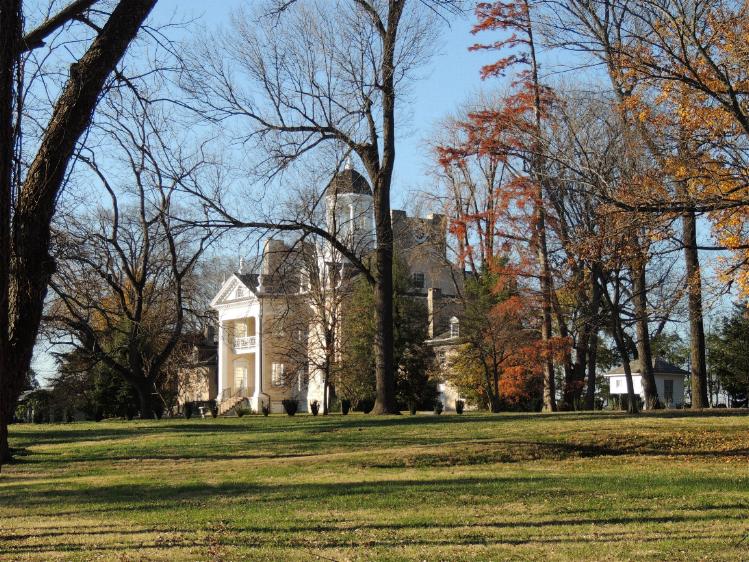
John Ridgely, Hampton’s Fifth Master
Charles died
of typhoid fever at the early age of 42 on March 29, 1872 in Rome, Italy. His
wife, Margaretta and their children returned to Hampton. Their son, John
Ridgely became the Hampton’s fifth Master. He and his wife, Helen and
mother Margaretta, who managed the estate from 1872 to 1900, tried hard to
preserve its former traditions.
Known as
“Captain” John Ridgely was the technical fifth master, but his mother
Margaretta actually ran the day-to-day operation. Upon Margaretta’s death in
1904, the estate was divided among several heirs. Captain John Ridgely
inherited only 1000 acres including the Home Farm.
John Ridgely, Jr., Hampton’s Sixth and Final Master
In 1905 the
Ridgely’s sold their town house in Bolton Hill and began year-round residence
at Hampton. While the lavish and elegant lifestyle of the past had diminished,
the estate was cared for but little improvement was made. The eldest son of
Captain John and Helen Ridgely would eventually become the Hampton’s sixth and
final master. John Ridgely, Jr. (1882-1959) married Louise Roman Humrichhouse
in 1907 and they built a large house located at 503 Hampton Lane. Here they
raised three children, the oldest named John Ridgely III (1911-1990). When
Louise died in 1934, John Ridgely Jr. moved back into the Hampton Mansion.
In 1935, John
Ridgely III, married Lillian Ketchum (1912-1995) and in 1936, moved to Hampton
Mansion.
Captain John
Ridgely died in 1938, having been the master for 66 years. The property
passed to John Ridgely Jr., who was the estate’s last private owner. In 1939
he married a second time to Jane Rodney.
Then John
Ridgely, III and his wife moved from the mansion to the Lower House, the first
Ridgely’s to live there since the 1780s. They left in 1942 when he served in
the Pacific during World War II. They returned in 1943.
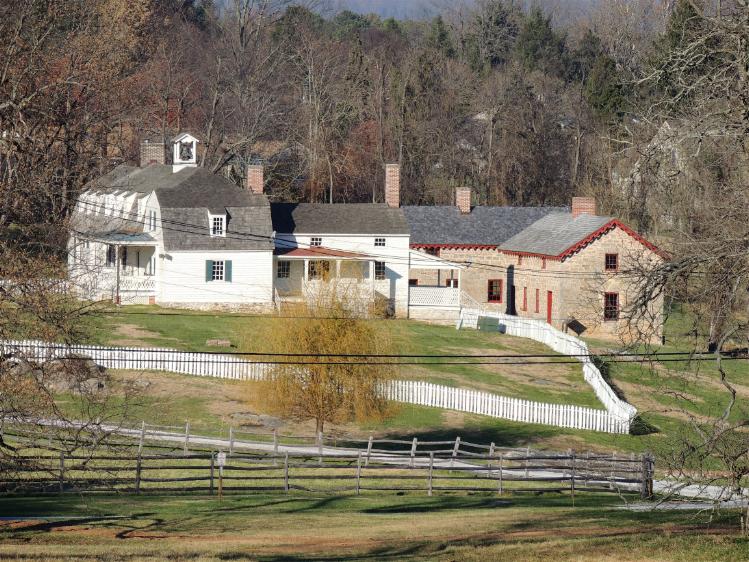
John Ridgely
and his second wife Jane Rodney moved to the Lower House which they then
enlarged by adding a four-room wing and modern conveniences. After John’s
death in 1959, Jane retained life tenancy until her death in 1978.
While they
lived in the Lower House, the Mansion House had officially been designed a
national Historic Site on June 22, 1948. The Mansion was restored on both its
interior and exterior and was opened to the public on May 2, 1950. In 19789
the national park service took over the administration of the Mansion and its
60 acres.
The Structures
on the Estate are: The Lower House; The Slave Quarters; The Stables; The Mule
barn; The Long House Granary; The Dairy; The Corncrib; The Log Cabin; and
several outbuildings near the Mansion. Also located here is: The Family
Cemetery, and The Furnace and Mill.
Also of note
are the Gardens and Grounds; the Orangery, the Greenhouses, and the Garden’s
Cottage, and the Entrance and the North Lawn.
Inside the
Mansion are the Period Rooms, They consist of: The Parlour; The Dining Room;
The Drawing Room; The Music Room; The Great Hall; The Master Bedchamber; The
Northeast Bedchamber; and The Guest Bedchamber.
The Parlour
When you visit
the Parlour, you are treated to the Mansion’s earliest period of occupancy. It
functioned then as a type of sitting or family room would today. It was also
used as a bedchamber for 18 months when Captain Charles Ridgely, “The
Builder,” resided in the Mansion. He died in his bed in this room in June
1790, after suffering a stroke. Today the Parlour is reflective of the tastes
and lifestyle of the Captain’s nephew and heir, Governor Charles Carnan
Ridgely, and his wife, Priscilla Hill Dorsey. It is decorated today as it
would have been at that time for activities as a family tea party. The Federal
era furnishings here are a set of chairs made for the Ridgely’s in the 1780s.
The Dining Room
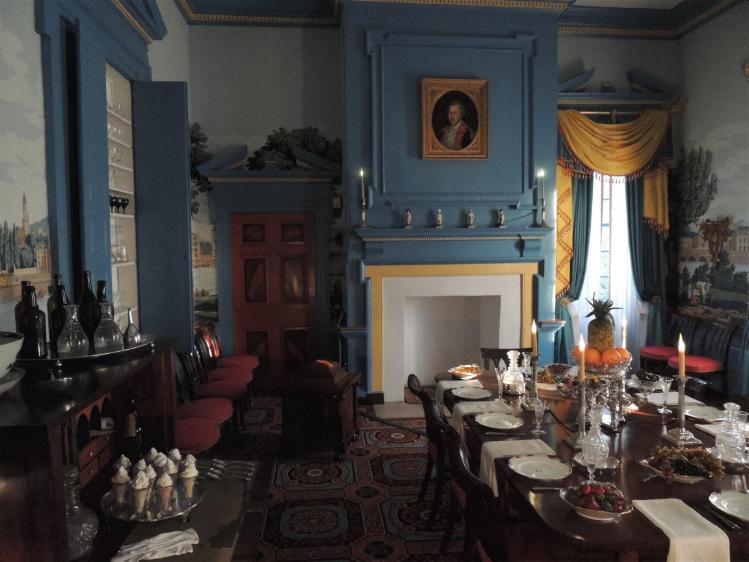
This room is
furnished to show what the Mansion was like between 1810 and 1829 when
Governor Charles Ridgely died. The settings seen here on the table reflect the
Governor’s taste and wealth. During the Christmas holiday, the table is set
for a formal dinner. In the summer months, it is set for a dessert course.
The colors of the Dining Room, that of Prussian blue and ocher, are based on
scientific analysis, and replicate the second layer of paint about 1810. The
wallpaper, “Monuments of Paris,” is a reproduction of the fashionable French
paper available at shops close to the Governor’s townhouse in Baltimore.
About 1810, the door in the northeast corner was added to provide direct
access to an expanded butler’s pantry and the kitchen beyond. Most of the
furniture was purchased by Governor Ridgely and were made in Baltimore between
1810 and 1825.
The Drawing Room
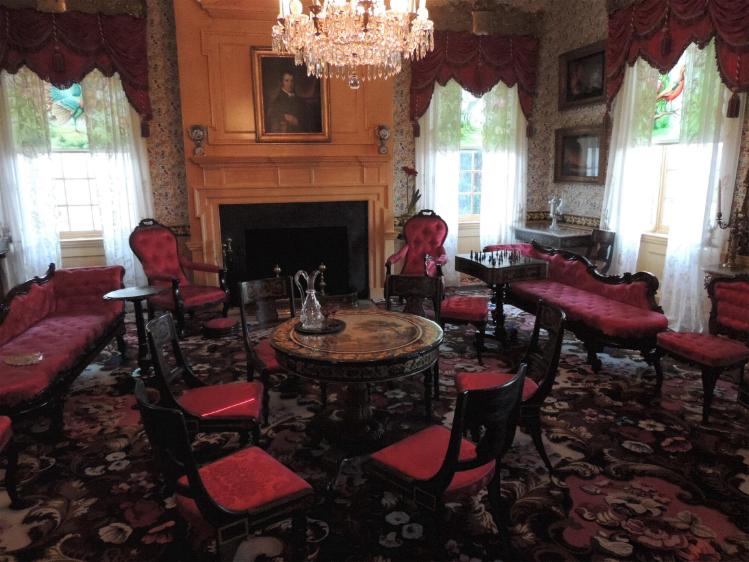
This is the
Mansion’s most formal room, and at all times of year contained the best
furniture and decorations. It was used to receive guests, entertain visitors,
and as after dinner receptions. It is furnished today to show what life was
life when John and Eliza Ridgely were master and mistress of Hampton. Of note
is the Baltimore Empire painted sofa with swan arm detail by John Finlay in
1832. Also here are a pair of enormous, custom-made gilded pier mirror and
matching window cornices that bear the family coat of arms supplied to the
Ridgely’s about 1843. Above the fireplace is a portrait painting of Charles
Carnan Ridgely, Jr., by J.W. Jarvis, ca.1812.
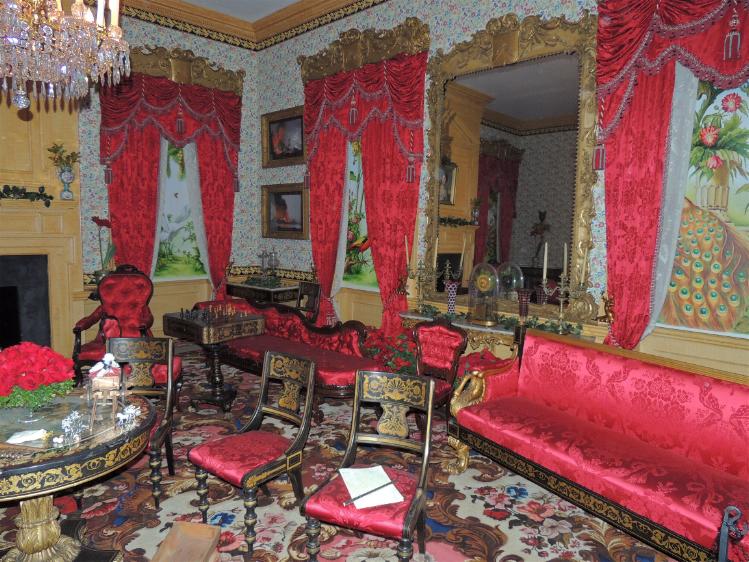
The Music Room
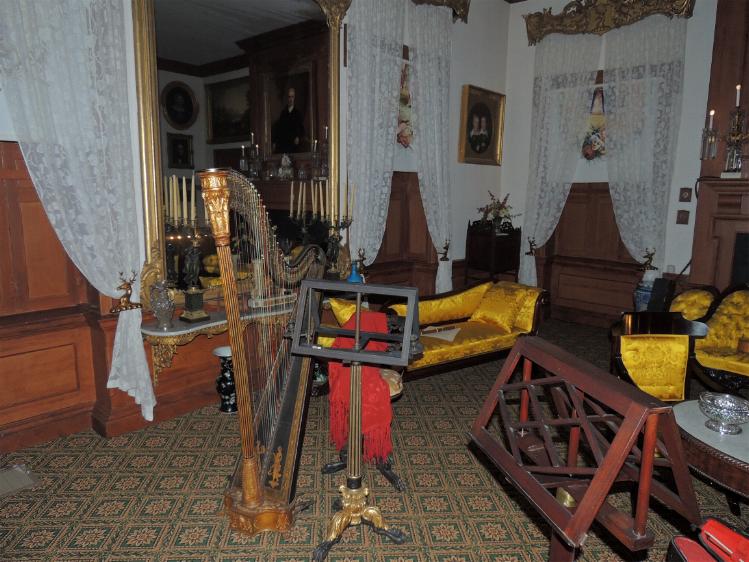
Another
fascinating room is the former southwest parlor known as the Music Room since
about the 1840s. At other times this room had other functions to include
serving as the principal library. Seen here are musical instruments including
a harp and piano, used to entertain guests. The harp seen here today was made
for Eliza Ridgely by Sebastian Erard of London in 1817. It was purchased for
Eliza by her father, Nicholas Greenbury Ridgely. The furnishings seen in the
Music Room today are those that reflect the period of a Victorian era about
1870-1890, of Margaretta Howard Ridgely, the widow of Charles Ridgely,
Hampton’s fourth Master. When Margaretta seldom made major purchases, it was
she that acquired the Steinway square grand piano made in New York in 1878.
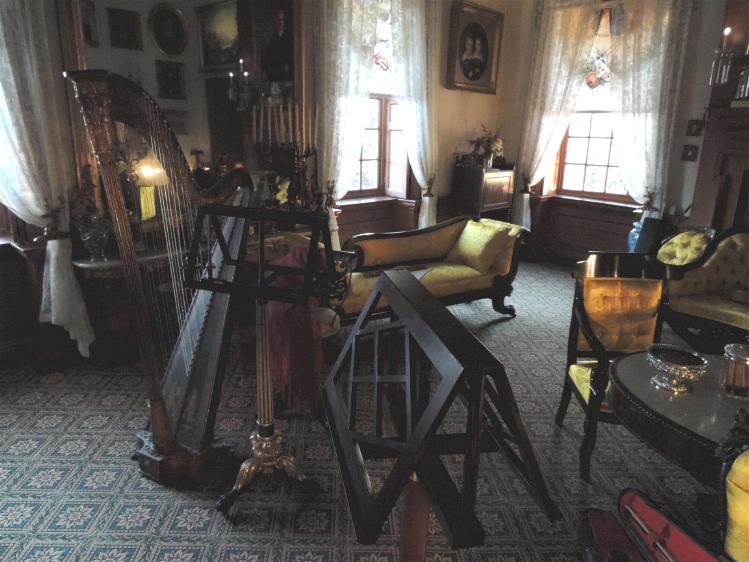
Research
through historic photographs show the music room filled with furnishings from
previous periods as well as the walls filled with family paintings. These
included portraits of family members from the 19th century to the
late 1870s. The hand-painted window shades are exact copies of the Hampton’s
collection, and feature allegories of Music, Theater and Gardening. Other
items of note, all made in Baltimore, are the large three-part sofa and lady’s
slipper chair made for Eliza Ridgely by the city’s leading cabinetmaker,
Robert Renwick in 1858.

The Great Hall
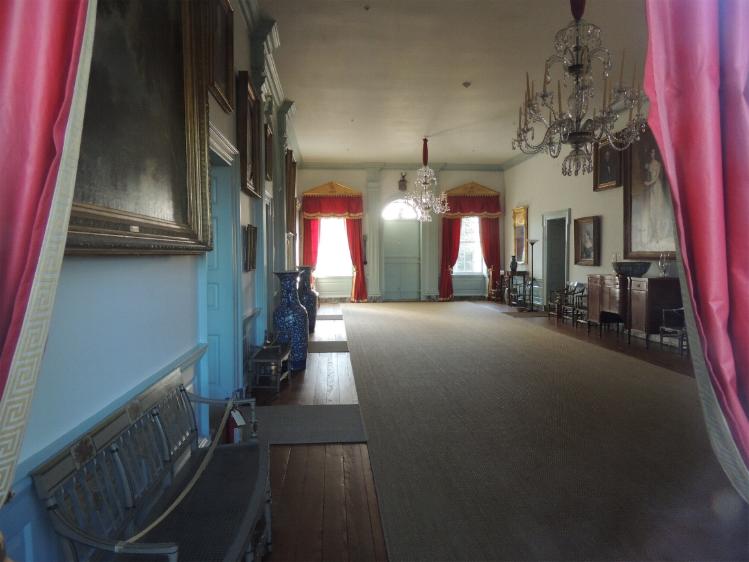
The
centerpiece of the Mansion is the Great Hall, measuring a very large fifty-one
feet by twenty-one feet. Over the history of the Mansion, this area was used
for many diverse purposes. The first mistress, Rebecca Dorsey Ridgely,
“inaugurated her house-warming by religious services and a watch meeting in
the large-hall.” During Governor Ridgely time, it was used for large parties
and ball. It is noted that one party had 51 people seated for dinner with
plenty of room to spare. Included here today are several pairs of Chinese
porcelain palace jars, the largest placed against the east wall. Despite the
fragile decorations, it is said that Eliza’s children exercised, and threw
snowballs in the Great Hall. In later years it was the site of Didy’s wedding
to John Campbell White. Somber occasions also involved the Great Room that of
the funerals of Eliza and her husband, John Ridgely. The 20th
century brought back its use for balls and other festive activities. During
this time, stained glass was installed in the four principal windows and
lights above the doors gave a chapel-like appearance.

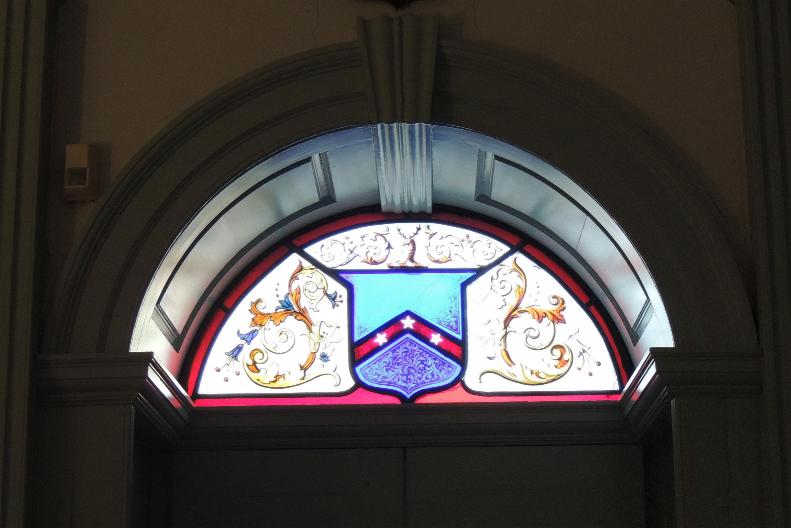
Seen today on
the walls are many portraits, including the young Eliza Ridgely, titled
Lady with a Harp. Also of note here is a Baltimore Federal painted
armchair from a set owned by John Eager Howard, ca.1810.
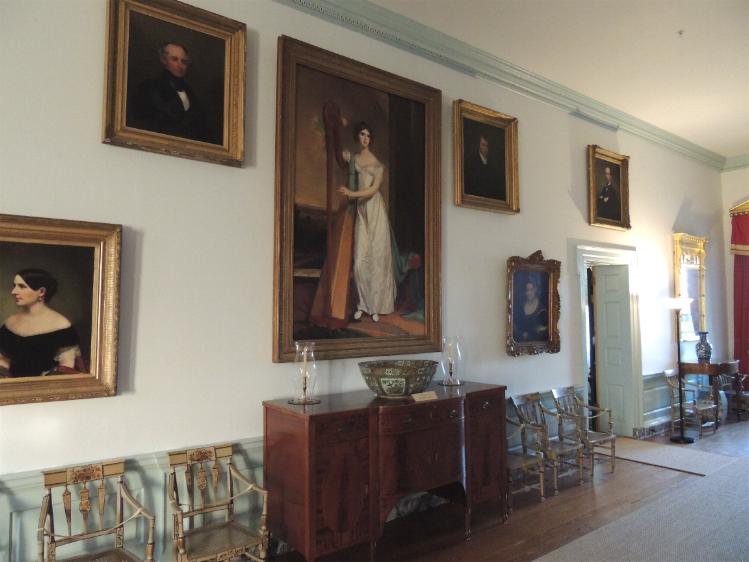
The Master Bedchamber
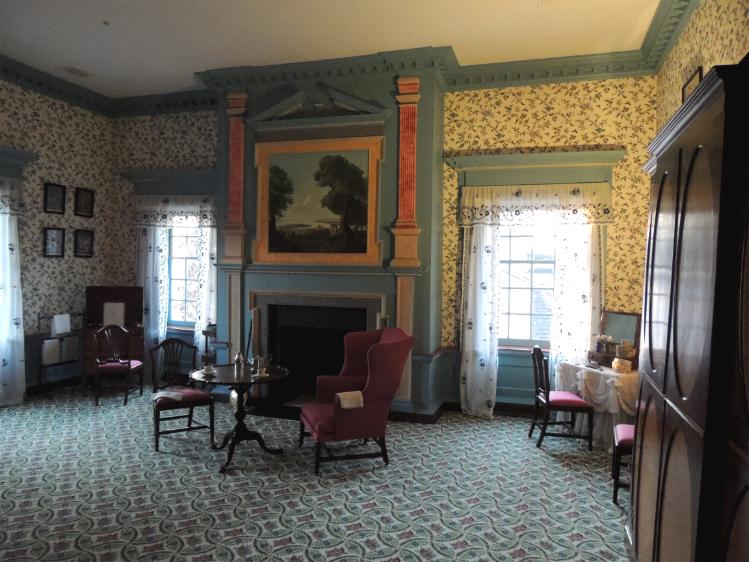
On the second
floor in the southwest corner is this room used historically as the principal
bedchamber. It is furnished to represent the period when occupied by Governor
Charles Carnan Ridgely and his wife, Priscilla. Guests would also be received
in the bedchamber, thus the elaborate decoration and furnishings. The painting
over the fireplace was copied from an 18th century view of
Baltimore by George Beck, now at the Maryland Historical Society. As Priscilla
had 14 children, the “lying-in” period after the birth of a child would be
used for friends and neighbors to visit, thus necessitating many chairs, seen
here today. The large mahogany was purchased about 1800, and the bed hangings
are from the 1790s. Also included here is a night table from ca.1800, and the
Beau Brummel, an English Hepplewhite gentlemen’s dressing table,
ca.1800.
The Northeast Bedchamber
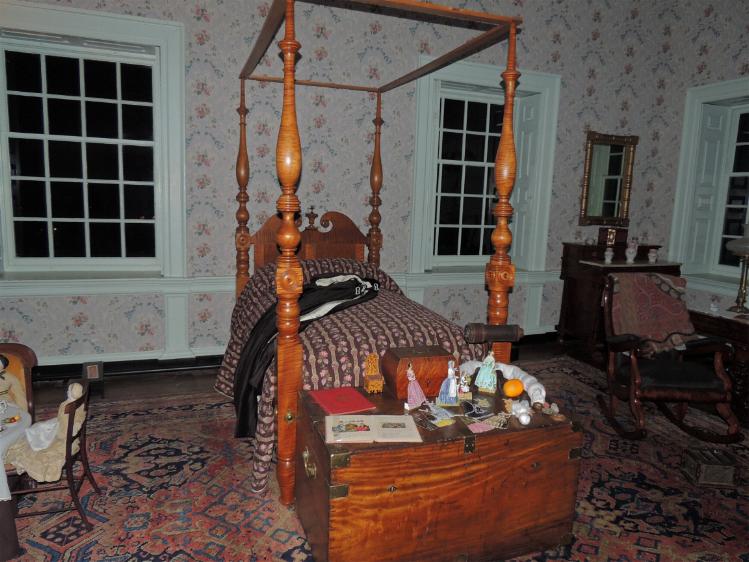
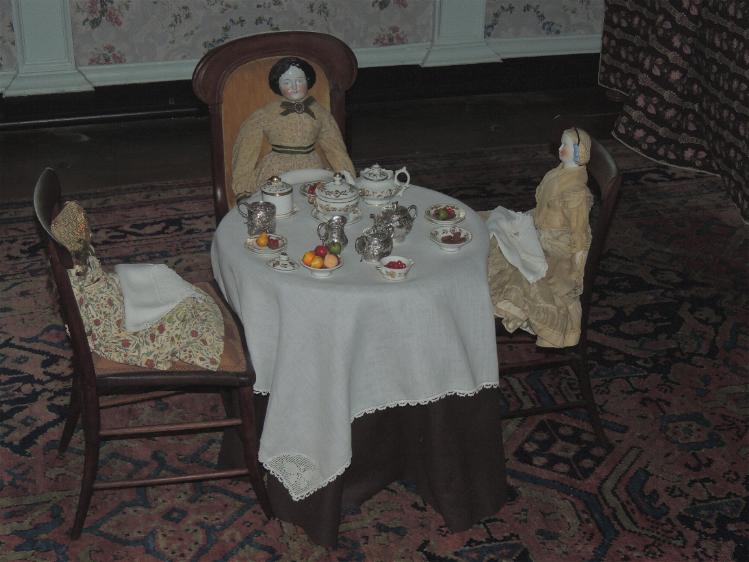
This second
floor room is reflective of a child’s room at the Mansion, showing what daily
life was like for the children of John and Eliza Ridgely. Their two surviving
children, Eliza, called “Didy,” and Charles grew up here and their bedrooms
were on the second floor. The furniture seen here is original from 1820 to
1840. The pair of wardrobes reminds us that there were no built-in closets in
the bedchambers. The maple post bed was made about 1830, probably by John
Needles, Baltimore’s leading Quaker cabinetmaker. On the wall is a Watercolor
painting of a child’s dancing party in Baltimore, ca.1843.
The Guest Bedchamber

This northwest
Bedchamber is furnished to the period from 1890 to 1910, highlighting the era
of Helen Stewart Ridgely, wife of Captain John Ridgely. The focal point is
the pastel portrait of Helen over the fireplace, by Baltimore artist Florence
Mackubin, 1904. Helen was an accomplished woman, as the author of two books,
and her involvement in numerous civic activities and her role in managing the
estate. This room today is viewed as though a female friend was visiting,
showing a suitcase, small trunk, hatbox, and other travel items. In the winter
months, a lady’s riding habit, hat and boots are displayed, suggesting this
visitor may go fox-hunting with the Ridgely’s, a favorite pastime. The top of
the Federal bureau shows ladies dressing accessories, and an English corner
washstand, ca.1810, has English ironstone china washstand set by J. & W.
Ridgway, ca.1830. The room-sized Turkey carpet was purchased by John and
Eliza Ridgely in the late 1850s.
Hampton at Christmas
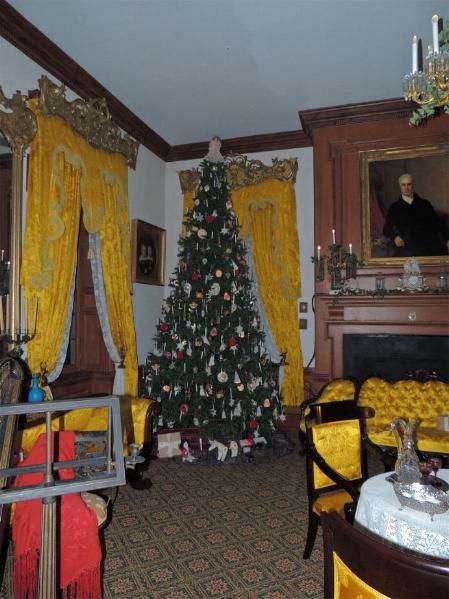
.JPG)
.JPG)
.JPG)
.JPG)
I highly
recommend a visit by all. It is a beautiful Mansion and grounds, with its
wonderful gardens. It should be visited at least twice a year; in the spring
or summer months, and during the Christmas holiday. To me, it’s comparable to
Maryland’s version of George Washington’s Mount Vernon. And, it’s FREE.
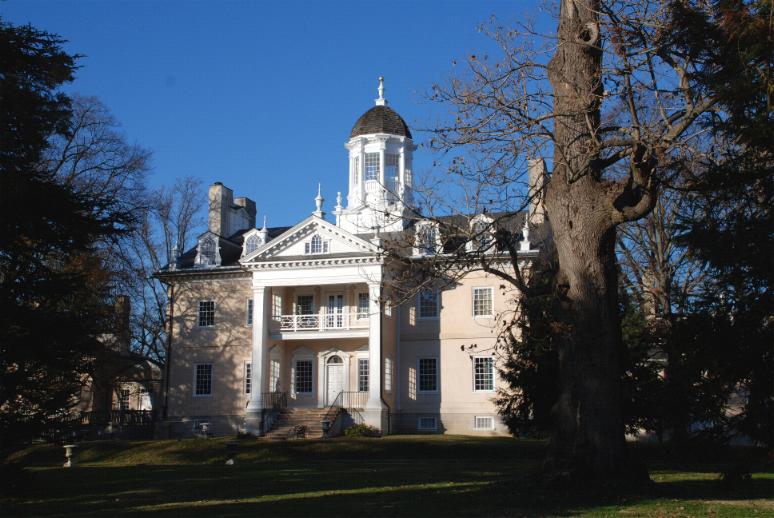
Edited by John T.
Marck. Majority of information taken directly from the Hampton National
Historic Site Guidebook, and the National Park Service., Copyright by the
National Park Service at Hampton National Historic Site. The Guidebook was
written by: Gay Vietzke, Superintendent; Vince Vaise, Chief of Interpretation;
Paul Bitzel, Chief of Resource Management; Gregory Weidman, Curator; Debbie
Patterson, Registrar; Kirby Shedlowski, Paul Plamann, and Catherine Holden,
Park Rangers; and Julia Lehnert, Archivist. Production of this guidebook is by
the support of Historic Hampton, Inc.
Also, Copyright
2013 by John T. Marck Informational assistance from the Hampton National
Historic Site and its Park Rangers. All photographs used herein are Copyright
© 2012-2013, by John T. Marck. Information from this article and its
photographs may not be used or reproduced without permission.
A Splendid Time Is Guaranteed For All.
| | |
| |
|

